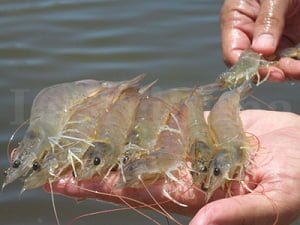
The nursery phase is crucial for healthy and productive shrimp farming. However, traditional nursery systems can face disease outbreaks and high mortality rates. This research investigated a new approach: using a symbiotic system (combination of probiotics and prebiotics) along with different population densities to improve shrimp health and growth.
Scientists from the Federal Institute of Education, Science and Technology of Ceará (Brazil), Biotrends Biotechnological Solutions (Brazil), Embrapa Coastal Plains (Brazil), the Federal University of Ceará (UFC), and the Federal Rural University of Pernambuco (UFRPE) evaluated the influence of shrimp (Penaeus vannamei) population density in a symbiotic tank system, focusing on growth, microbial composition, and water quality.
Symbiotics: A Boost for Shrimp
The study utilized a symbiotic tank system. Symbiotics combine probiotics (beneficial bacteria) with prebiotics (nutrients that promote the growth of probiotics) to create a healthy gut microbiome for shrimp. This approach aims to enhance shrimp health and disease resistance.
The concept of symbiotics employs a holistic method to balance the relationship between phytoplankton and other microorganisms (bacteria, zooplankton, etc.), resulting in a “mature” environment and stable water quality parameters.
Previous studies have reported that symbiotics improve shrimp growth while maintaining adequate water quality.
The Experiment: Finding the Balance
The study focused on Pacific white shrimp (Penaeus vannamei) and evaluated three population densities: 2000, 4000, and 6000 post-larvae (PL10) per cubic meter (m³). Each tank received a symbiotic mix of rice bran, brown sugar, a commercial probiotic, and sterilized water before stocking the shrimp.
The experiment lasted 30 days, during which water quality and microbial communities were continuously monitored.
Results: Less is More for Optimal Growth
The results revealed a clear advantage for the lower population density (2,000 PL/m³). Shrimp at this density exhibited:
- Higher final weight
- Improved survival rates
- Better feed conversion ratio (meaning less feed wastage)
- Faster weekly growth rate
- Increased productivity
Interestingly, the symbiotic treatment seemed to benefit all population densities, with increases observed in:
Stay Always Informed
Join our communities to instantly receive the most important news, reports, and analysis from the aquaculture industry.
- Vibrio spp. (though not a significant finding): a group of bacteria that can include both beneficial and pathogenic strains. More research is needed to understand the specific impact in this context.
- Lactobacillus spp.: beneficial bacteria known to promote gut health in shrimp.
- Total heterotrophic bacteria: a general indicator of microbial activity in the water.
- Yeast count (with significant differences): the role of yeast in this system requires further investigation.
Water quality remained stable across all densities, with no significant differences in ammonia, nitrite, and nitrate levels.
Recommendations for Shrimp Producers
According to this study, using a population density of 2000 PL/m³ along with a symbiotic nursery system appears to be the most effective approach. This combination promotes optimal shrimp growth, survival, and overall health while maintaining good water quality.
While the symbiotic treatment showed promise, further studies are needed to fully understand the impact on specific bacterial strains within the shrimp’s gut microbiome. This will provide a deeper understanding of how symbiotics can be optimized to further enhance shrimp health and performance.
Conclusion: Adjusting Population Density for Success
This study highlights the importance of optimizing population density within a symbiotic nursery system. By using a lower density (2000 PL m-3), shrimp producers can potentially achieve better growth, survival, and overall health of their populations. Additionally, the symbiotic approach seems to promote a healthy gut microbiome, which could contribute to improved shrimp resilience.
This research offers valuable insights for shrimp producers looking to optimize their nursery systems. By implementing a lower population density and incorporating a symbiotic approach, producers can potentially achieve higher yields and healthier shrimp.
The study was funded by the Coordination for the Improvement of Higher Education Personnel/CAPES – Financing Code 001 and SEBRAE (Brazilian Service of Support for Micro and Small Enterprises).
Contact
Jhonatas Teixeira Viana
Laboratório de Biotecnologia Aquícola (LABIAq), Instituto Federal de Educação, Ciência e Tecnologia do Ceará
Acaraú, CE, 62580-000, Brazil
Email: jhonatas.viana@ifce.edu.br
Reference
Coutinho, A.G., Viana, J.T., Angelim, A.L. et al. Evaluation of the stocking density of postlarvae of Penaeus vannamei in synbiotic nursery system. Aquacult Int (2024). https://doi.org/10.1007/s10499-024-01595-0
Editor at the digital magazine AquaHoy. He holds a degree in Aquaculture Biology from the National University of Santa (UNS) and a Master’s degree in Science and Innovation Management from the Polytechnic University of Valencia, with postgraduate diplomas in Business Innovation and Innovation Management. He possesses extensive experience in the aquaculture and fisheries sector, having led the Fisheries Innovation Unit of the National Program for Innovation in Fisheries and Aquaculture (PNIPA). He has served as a senior consultant in technology watch, an innovation project formulator and advisor, and a lecturer at UNS. He is a member of the Peruvian College of Biologists and was recognized by the World Aquaculture Society (WAS) in 2016 for his contribution to aquaculture.




